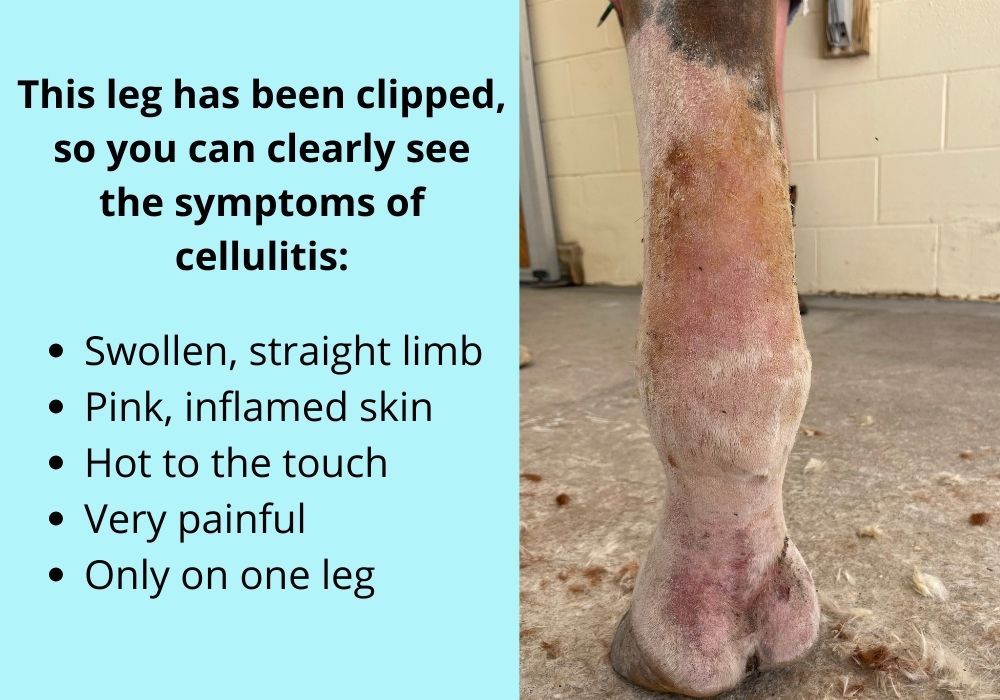Tuesdays with Tony
Why do horses like to do things as a crowd? As an independent-minded cat, I certainly don’t follow a crowd, but horses, they seem drawn to what others are doing. Where am I going with this, you ask? It seems that things come in groups. This week has been cellulitis week. Colic weeks are usually understandable. The weather got cold (usually the culprit), or hot (sometimes the culprit). However, the weeks of ‘everyone has cellulitis, or lacerations, or eye ulcers, or random fevers’ are less easy to explain. Since this has been the week of cellulitis, let’s talk about cellulitis.
What is Cellulitis?
Cellulitis is a bacterial infection that develops in the soft connective tissues beneath the horse’s skin. It can occur anywhere on the body, but most commonly occurs on limbs and more specifically, on hind limbs. Bacteria enter through a cut or laceration on the skin and spread quickly. Bacteria are such small little critters; they can weasel their way inside through a tiny little break in the skin. It could be so small that it was never even recognized even by the most diligent of owners. I’m sure I would notice a small cut on my skin. I do have cat eyes, after all. Lucky for you all, I perform “CAT” scans on all of your horses when they come into the clinic and alert the docs to any areas of concern to help prevent any problems for your horse in the future. That being said, it is very easy for small cuts to go unnoticed and allow bacteria to enter and infection to spread, thus resulting in cellulitis.
Clinical Signs
Have you ever seen an elephant’s leg? Well, I have (I mean, we’ve all seen pictures, right?), and let me tell you, elephant legs are GINORMOUS! I know what you’re thinking: Tony, why are you talking about elephants? This is supposed to be a blog about horses. Bear with me, I want you all to picture what an elephant leg looks like. It’s huge, it is relatively straight, and it doesn’t have the nice contours that horse legs have. Imagine walking out to your horse one day, and you notice one of his legs looks like an elephant leg. That’s what a horse with cellulitis looks like.

Cellulitis is not your typical stocking up of legs. Stocking up usually occurs in at least 2 if not 4 legs, whereas cellulitis is almost always localized to one leg. Horses with cellulitis are very painful, to the point that they will not put any weight on the affected limb. The limb will be hot to the touch, and even more painful. The skin will sometimes ooze and crack from all the swelling. You may notice that your horse becomes lethargic, he may run a fever, and may even decide he doesn’t want to eat. Man, cellulitis must be a pretty bad deal if a horse doesn’t want to eat! I know I have to be all out of sorts if I am going to miss a meal.
Diagnosis
If you suspect your horse might have cellulitis, the first thing you’re going to do is call my docs so they can come out and assess the problem. While acute cellulitis is not life-threatening, if left untreated it can quickly become a life-threatening situation and should always be treated as an urgent matter. Diagnosis may be made on physical examination alone, however, it is important to rule out other possibilities such as fractures. My docs may recommend radiographs or ultrasound to rule out other reasons your horse may be so uncomfortable. Similarly, they will likely want to run bloodwork to assess white blood cell count as well as other organ function to determine the severity of infection. Once all the information has been gathered, a diagnosis is made.
Treatment
Once a diagnosis has been made, treatment can begin. Treatment is targeted at treating the infection, controlling pain, and reducing swelling. Antibiotic therapy may include intravenous and/or intramuscular injections; however, oral antibiotics are usually the first course of treatment. Non-steroidal anti-inflammatories such as bute or banamine are used to help control pain and reduce inflammation. I’ve said it before and I am going to say it again: dilution is the solution to pollution, meaning, water, lots of water. Cold hosing the affected limb is a vital part in treating cellulitis. It reduces inflammation and relieves pain. Controlled exercise, while it sounds horrible to me, is also an important aspect of treating cellulitis. My docs may also recommend bandaging this affected limb as well as the support limb to decrease swelling and increase circulation to promote healing. Occasionally, hospitalization is necessary, and surgery can be required. However, if recognized and treated early, at-home treatment for cellulitis can usually be successful.
Complications
As with everything horse-related, cellulitis can’t just be simple and an easy fix. There are certain complications that can develop, especially if left untreated. The biggest complication (and one of major concern) is support-limb laminitis. This, as you all know, can be a big problem and can even be life-threatening. Support-limb laminitis occurs because the horse does not want to put any weight on the affected leg and is therefore bearing all his body weight on the other 3 limbs, and more specifically, a significant amount of weight is placed on the limb opposite the affected limb.
Without being able to rest the other limbs appropriately, inflammation develops in the horse’s foot and can result in laminitis. Laminitis can lead to rotation and sinking of the coffin bone and can be extremely painful, not to mention, expensive to treat. Why horses evolved to walk around on 1 finger is beyond me and supports my belief that cats are the superior species.
The swelling associated with cellulitis can also lead to sloughing of the skin on the affected leg. This opens up the limb to further infection, which can affect the deeper structures within the limb and require intensive, long term treatment including hospitalization, antibiotic therapy and daily bandage changes. All of this can end up being very costly for your horse. Unfortunately, these complications can occur despite everyone’s best effort to treat cellulitis quickly and effectively.
Prognosis
If recognized early, and treated promptly by my docs, cellulitis can resolve quickly and without complication, getting you back in the saddle in no time. However, as you can see, there are some very serious complications that can occur. Most horses can recover without secondary complications.
It’s important to note that once one episode of cellulitis occurs, it does then make your horse more prone to cellulitis in the future. In some cases, horses will develop scar tissue in the affected limb resulting in a limb that is larger than the others. It is also possible for cellulitis to lead to lameness, which mean cellulitis can be career-ending for some horses. Strict management of horses who have had cellulitis in the past is imperative. These horses tend to do best with ample turnout, sometimes even 24/7 turnout. I sure wish my minions would allow me to have 24/7 turnout!
Horses who have had cellulitis also benefit from a strict exercise program. Apparently, they need to move around a lot, including long warm-ups and long cool-downs. And as always, cold water therapy will help these guys in the long run. Thank goodness cats aren’t prone to cellulitis… exercise and cold water, no thank you!
Moral of the story is, if you think your horse is developing cellulitis, call my docs immediately so they can get your horse on the right track to recovery. Remember, it is always better to call and have my docs out for something small, before it becomes a bigger issue with further complications and a less-positive outcome.
Until next week,
~Tony
P.S. Are you following my YouTube Channel? The humans are putting out all kinds of great videos, the most recent of which is about how to hold your horse for the veterinarian for various things. They’ve got all kinds of stuff over there, so make sure you subscribe and get the new video every month. You can thank me later with a nice cat treat.
Tuesdays with Tony is the official blog of Tony the Clinic Cat at Springhill Equine Veterinary Clinic in Newberry, Florida. If you liked this blog, please subscribe below, and share it with your friends on social media! For more information, please call us at (352) 472-1620, visit our website at SpringhillEquine.com, or follow us on Facebook!
[jetpack_subscription_form title="Subscribe to Whinny's Wisdoms"]

